2018 Aprilia Shiver Review – 2018 Aprilia Dorsoduro Review
Trev tests Aprilia’s new 900cc Nakedbikes
Motorcycle Test by Trevor Hedge – Images by Ben Galli
Both Aprilia’s Supermoto-styled Dorsuduro and its more amenable naked sibling, the Shiver, first began life a decade ago in 750cc form. The Shiver was also the first mainstream machine to boast a fly-by-wire throttle, while an angry 1200cc model of the Dorsoduro joined the range in 2011.
With powerhouse Nakedbike duties for Aprilia now comprehensively addressed by the 175 horsepower 1077cc V4 Tuono R, this year’s Dorsoduro and Shiver range for Australia comes down to only one entirely new capacity, the 900cc Dorsoduro and Shiver.
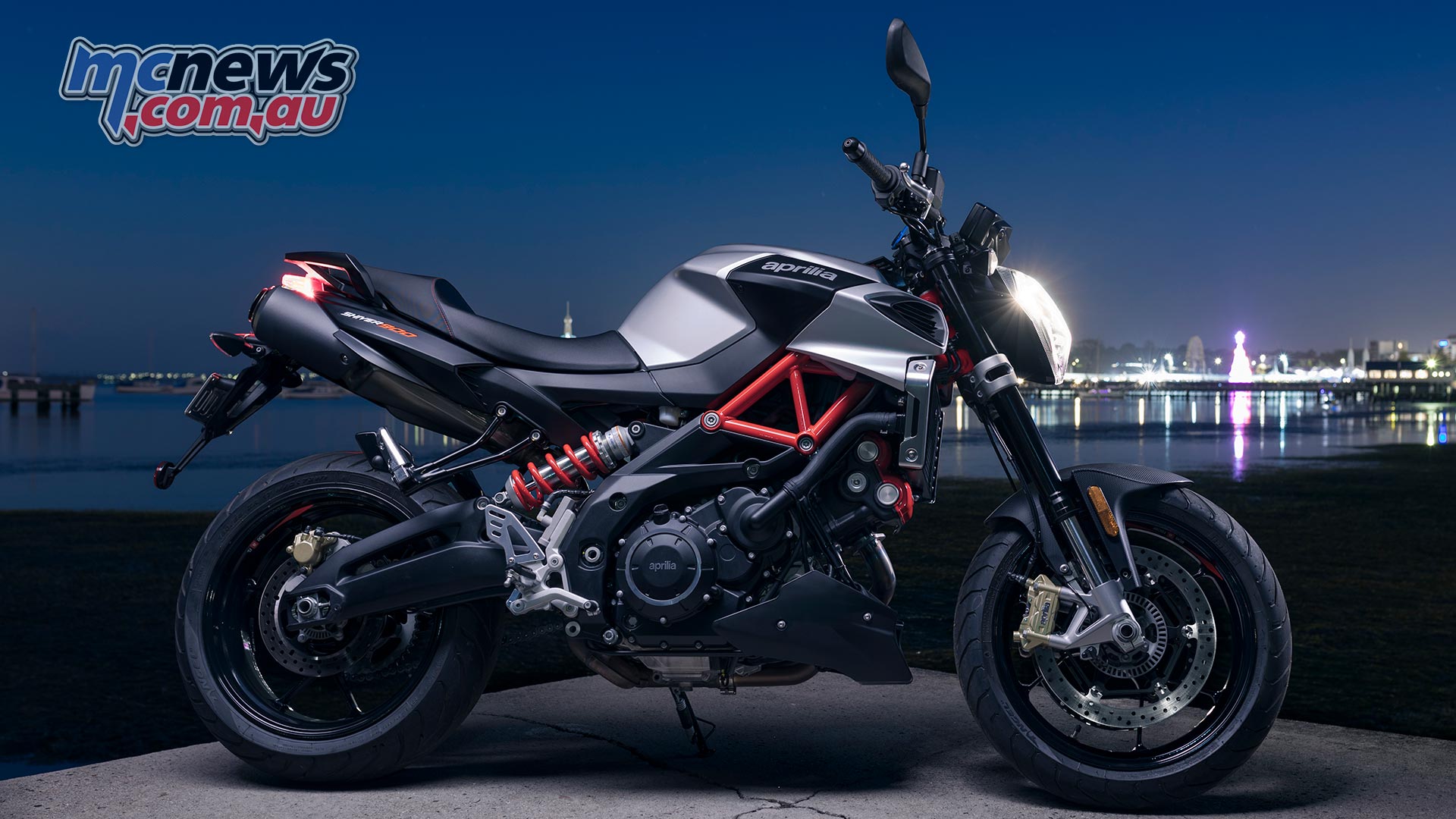
The new donk is derived from the original 90-degree 750cc V-Twin (or L-Twin if you like that Ducati derived terminology better), but with the stroke now extended from 56.4mm to 67.4mm to produce a new 896cc powerplant. Also new is the reed-valve scavenging system in the crankcases, which reduces pumping losses and helps negate the need for an oil cooler.
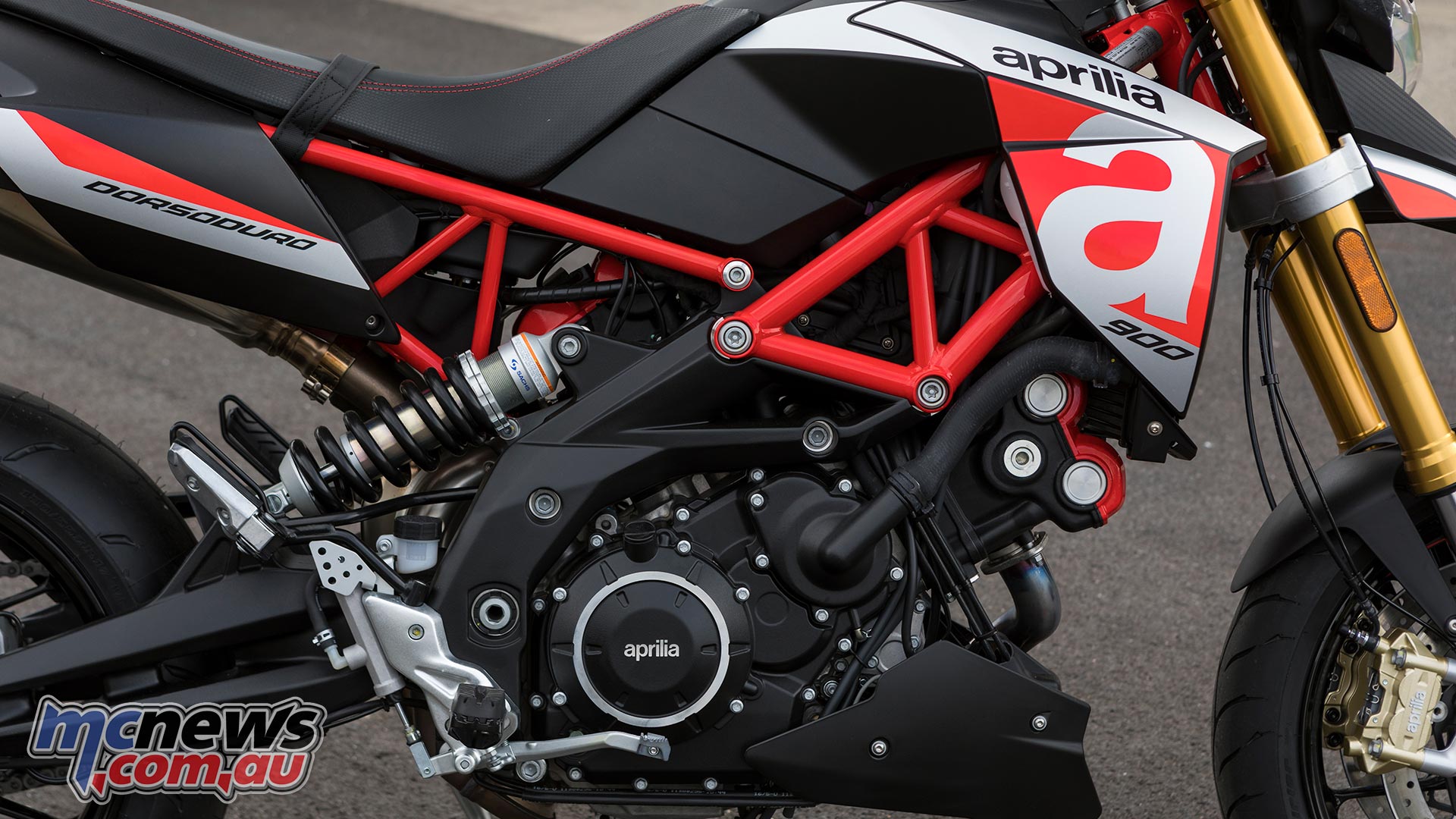
Curiously, despite the 20 per cent capacity hike, claimed power climbs only marginally, from 92hp to 95hp, arriving at the same 8750rpm as before. Euro4 emissions legislation perhaps?
Even more curious is the fact that while torque has climbed a little more substantially, from 82Nm to a strong 90Nm, that torque peak is at 6500, 2000rpm higher than on the much shorter-stroke 750cc engine. I struggled to get my head around that one, but Aprilia did promise that despite the actual torque peak being higher in the rev range, there was now more torque everywhere than the smaller donk provided.
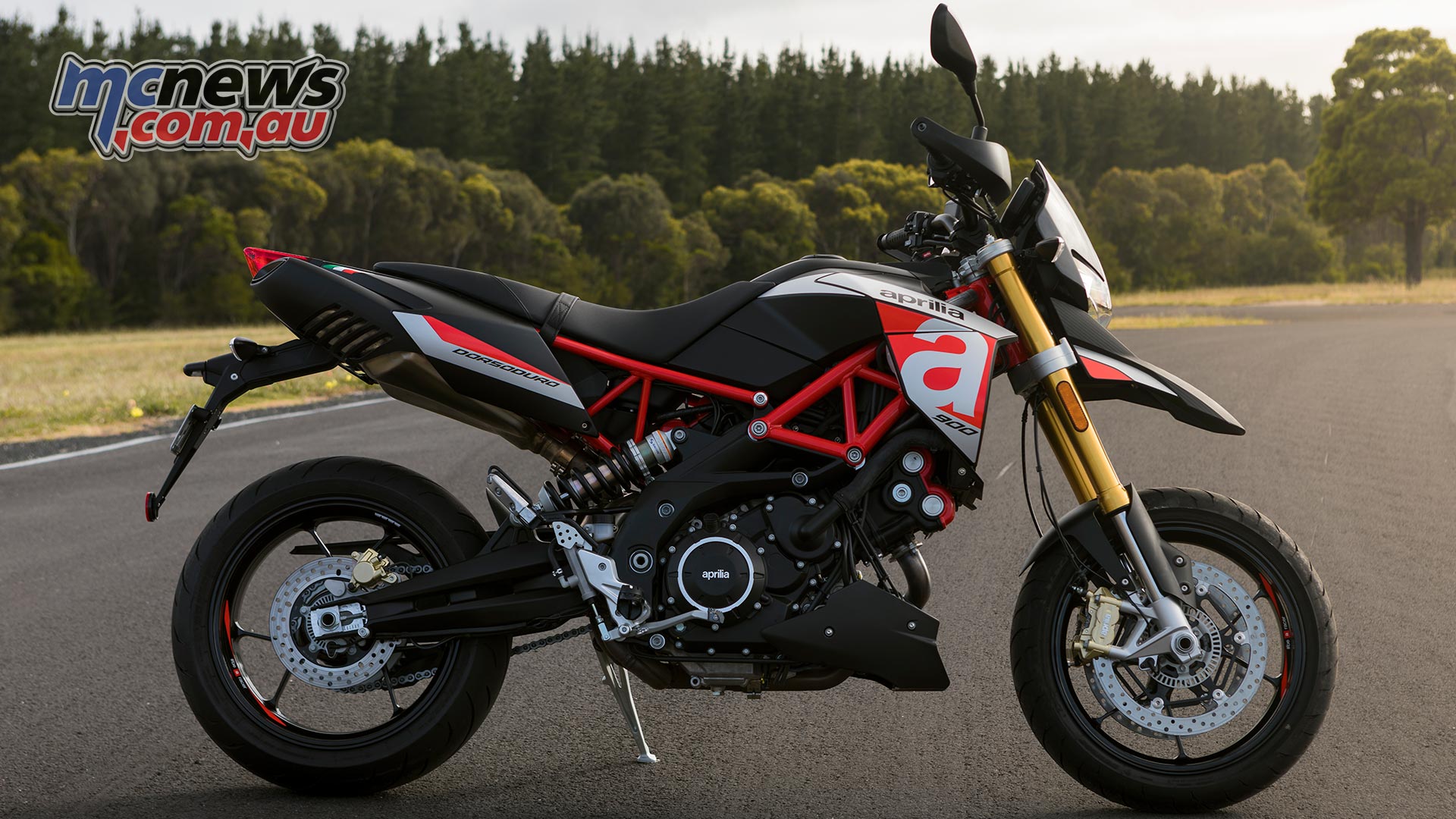
I am relieved to report that is very much the case. The new generation engine produces perhaps the most linear power delivery I have ever experienced.
There is no real crescendo to speak of, thus it almost feels flat, but there can be no argument that rapid forward progress is being made and that fat gobs of torque are being fed to the rear tyre.
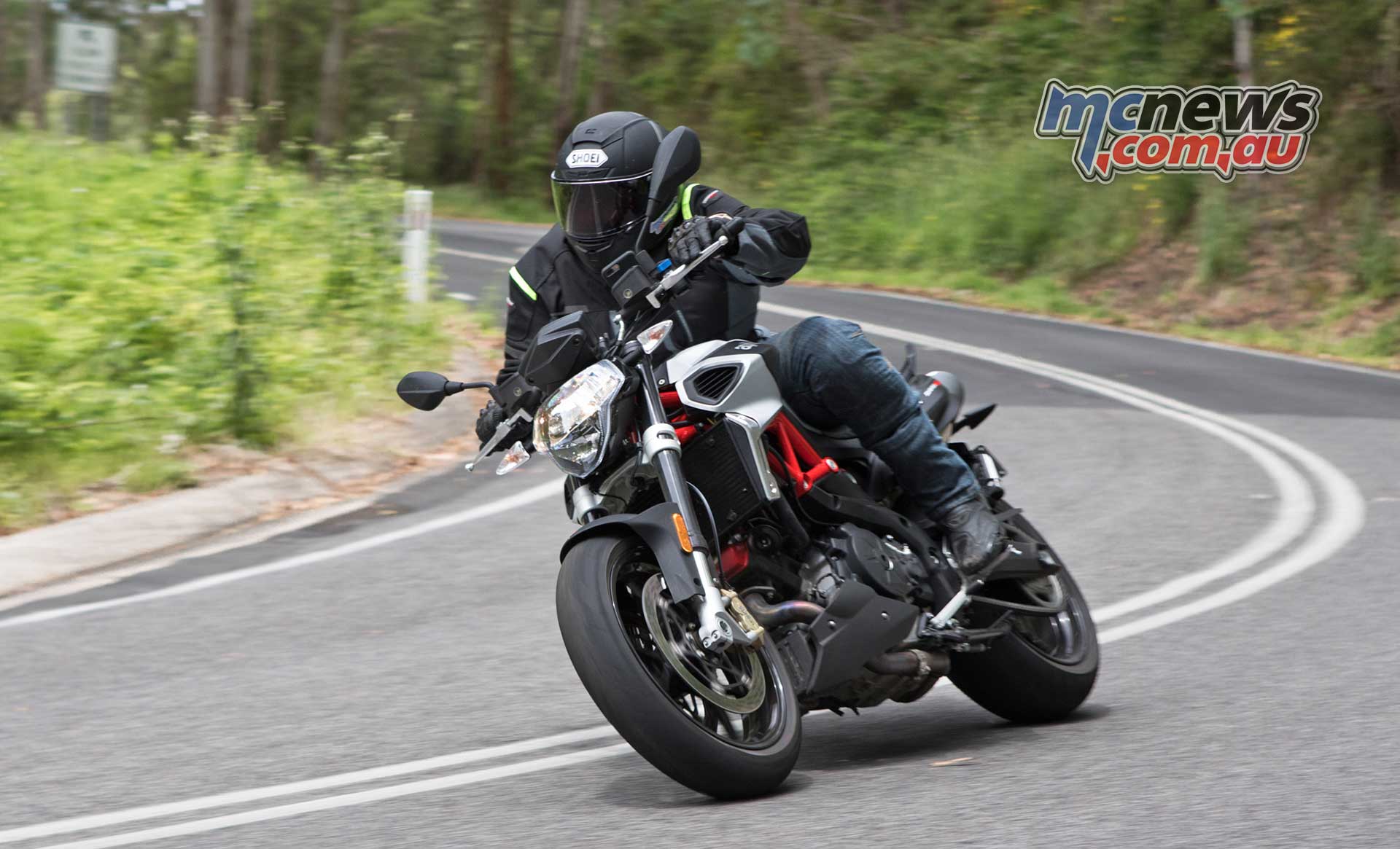
Fellow tester Steve Martin even remarked on the lines of 180/55 Pirelli Angel ST appearing on the road from the rear of the Shiver as I chased a 1100 Tuono-mounted lead-rider along Victoria’s Great Ocean Road.
For that run, and most of our time with the bikes, I had the engine in ‘Sport’ mode and the traction control set to Level One, which is the least intrusive of the three settings. The system can also be turned off but I only bothered to do that when pulling monos, which, by the way, were no easy task to get the hang of on either the Dorsoduro or Shiver.
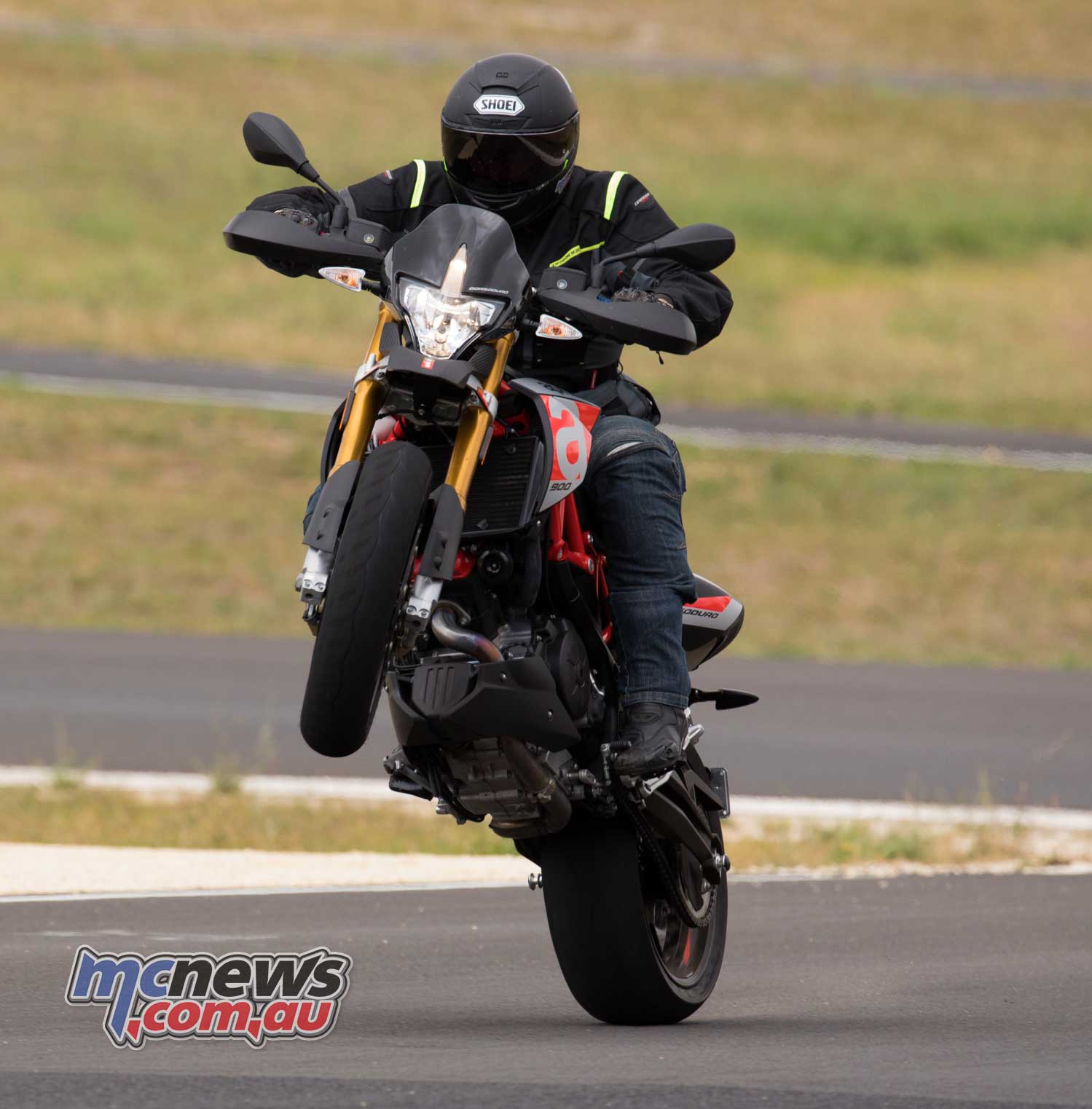
On the road the engine proves strong and flexible. Both machines now use the same high-spec Marelli 7 SM ECU fly-by-wire throttle as the RSV4 and Tuono. Three power maps are available and switchable on-the-fly from the bars, Sport, Touring and Rain. The Rain map is the only one that reduces peak power output, knocking about 25 horsepower off the top-end and providing the softest throttle response. Sport mode, as you would expect, is the most direct, while Touring just slows the throttle action up a little on the 52mm throttle bodies to smooth things out.
In any mode though, the throttle response is thoroughly friendly and the smoothness of the response perhaps actually dulls the excitement a little. The brilliant engineer responsible in Noale is probably working out ways he can stab me to death after spending countless hours refining the mapping to almost flawless, only for some hack to say it has dulled the character somewhat…
Both the riding mode and traction control settings are switchable on-the fly.
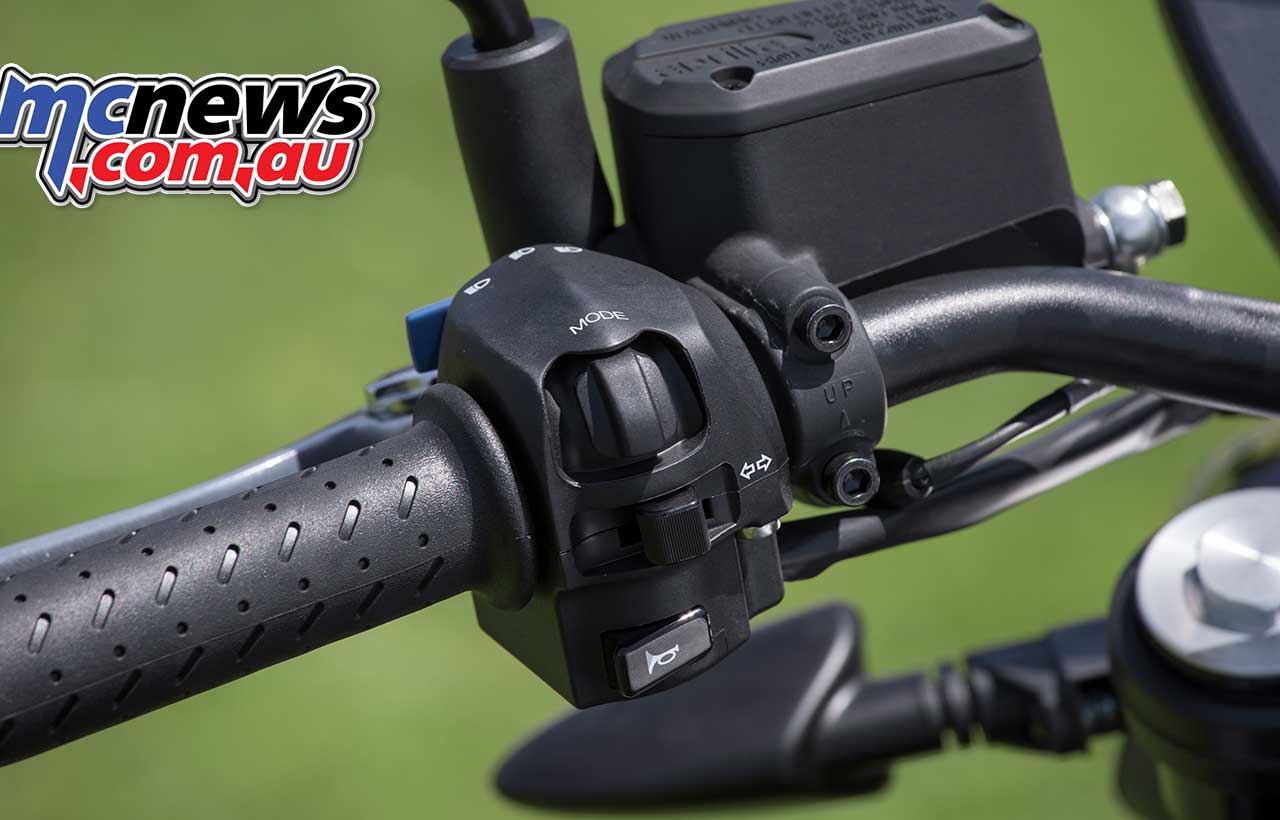
A flashing shift-light is programmable and on my test machine flashed as I approached 9500rpm before the machine struck a beautifully gentle rev-limiter a little over 10,000rpm. It redefines ‘soft-touch’ in the world of rev-limiters, and is so flawless that you actually don’t mind brushing the limiter every now and then between corners, to save a gear-change.
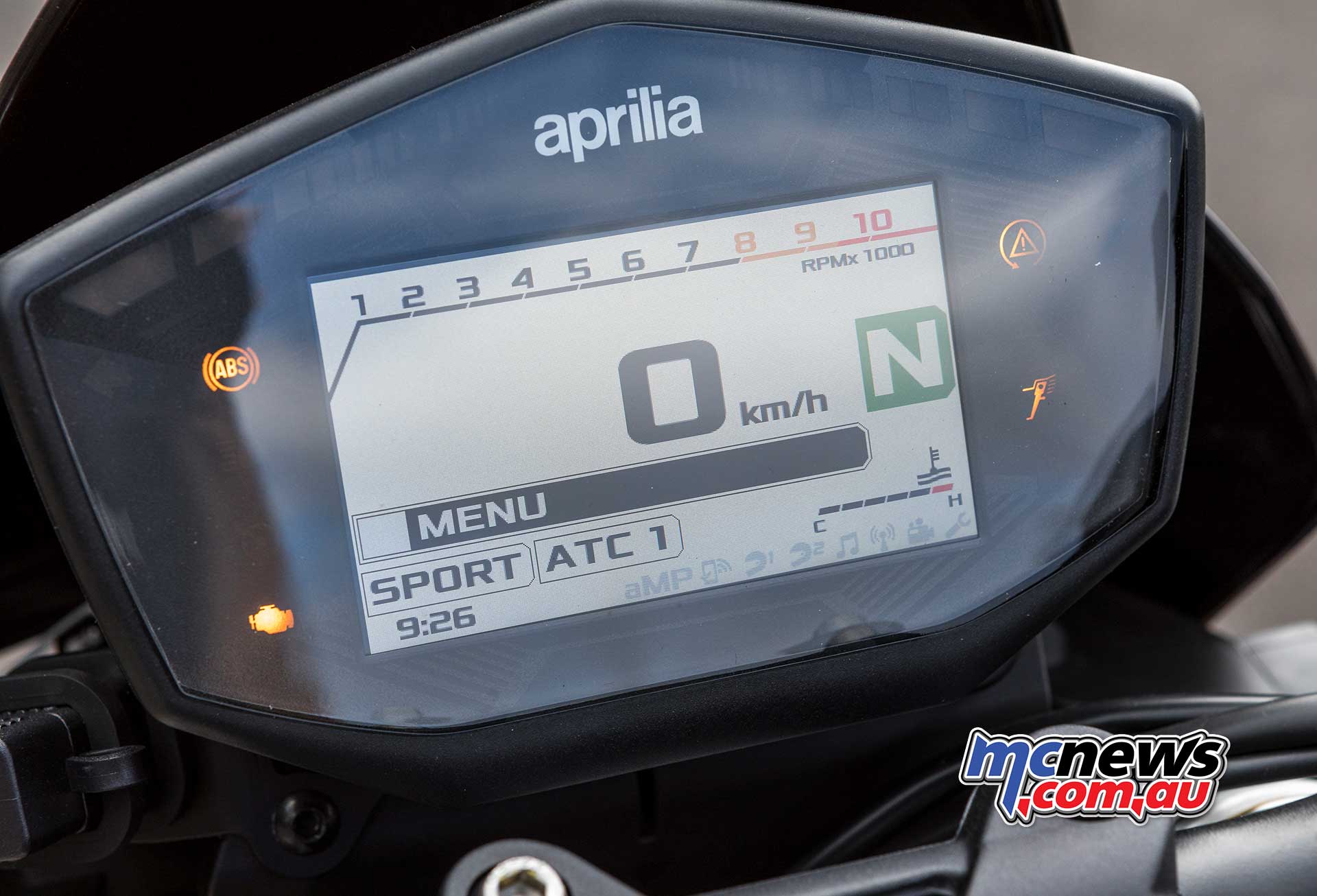
Aprilia claim that 15 per cent less effort is required at the clutch lever compared to their predecessors, however I still found it a little heavy compared to most modern motorcycles. The six-speed gearbox though was virtually flawless; shifts up and down the box were smooth and fuss free. Some others on the launch were not so complimentary on the shift quality, but the mounts I rode shifted very nicely indeed.
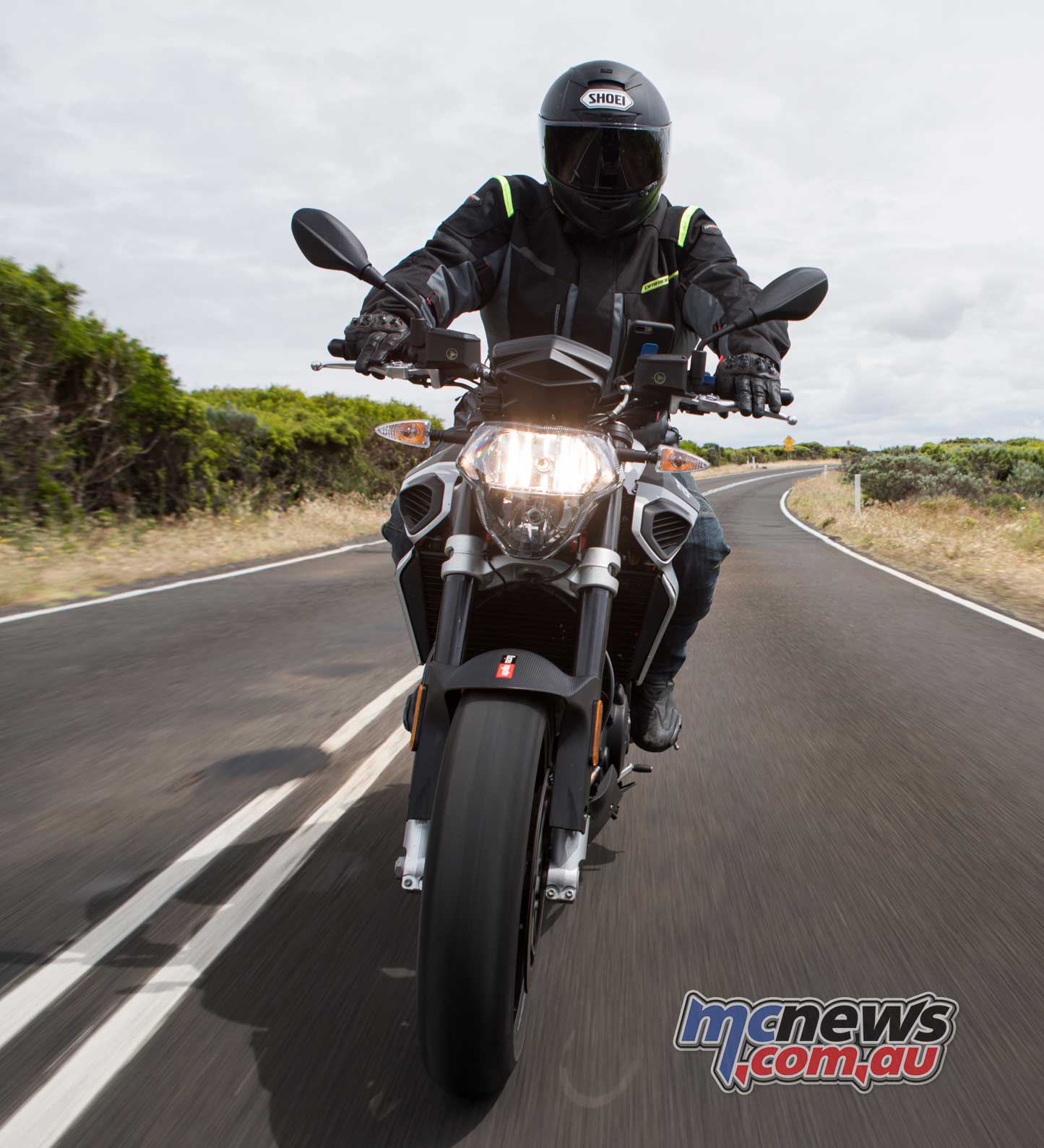
Braking hardware is provided by Brembo but it is proud Aprilia branding that adorns the radial-mount four-piston calipers. Along with braided lines and a pair of 320mm disc rotors, the braking hardware certainly ticks the boxes.
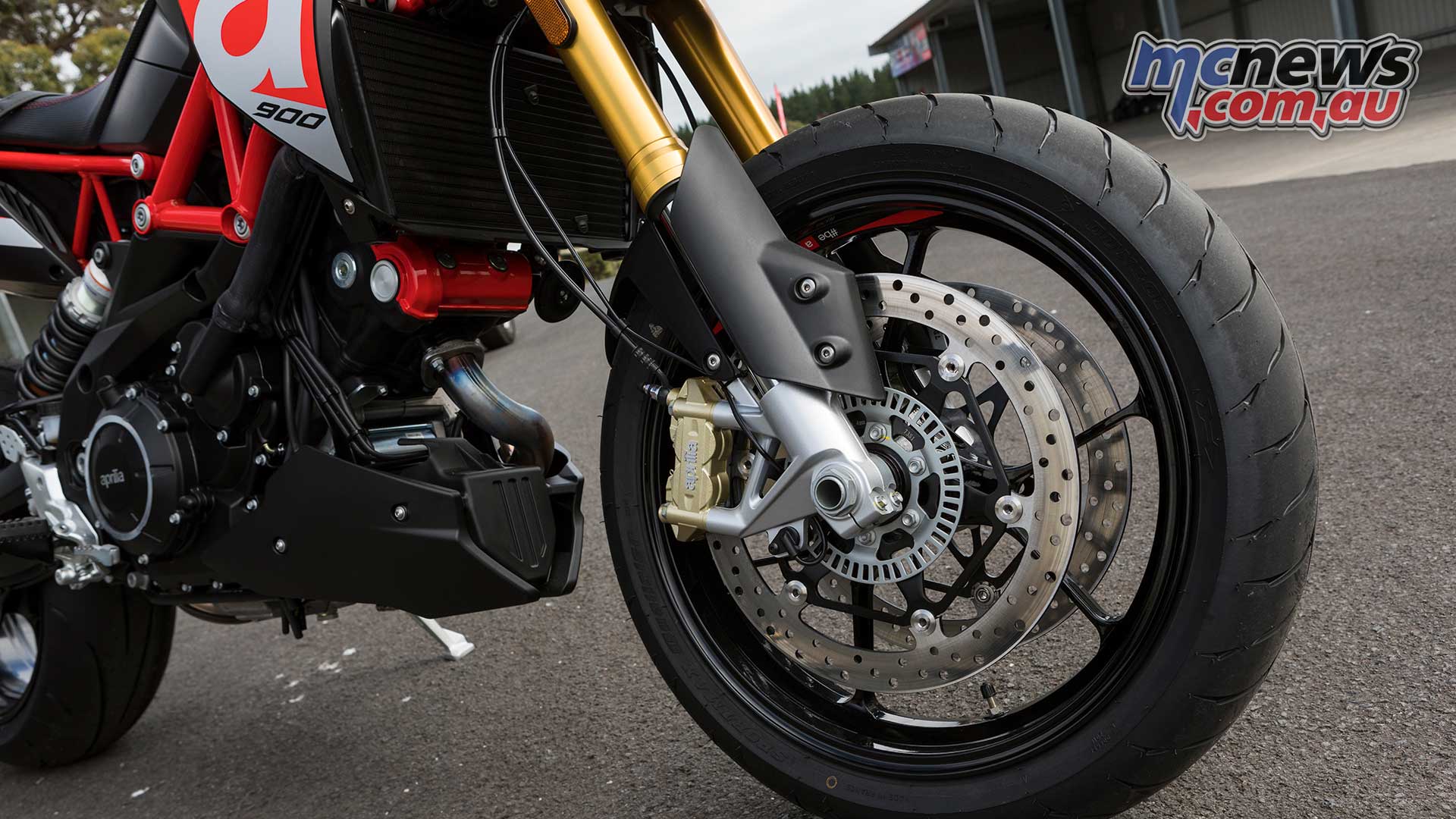
However, I found, like the clutch, that the effort required at the lever became a little taxing when playing hard. I suspect the standard pads being a little on the soft side as the culprits, and am fairly sure more aggressive pads would bite much better and help reduce effort at the lever.
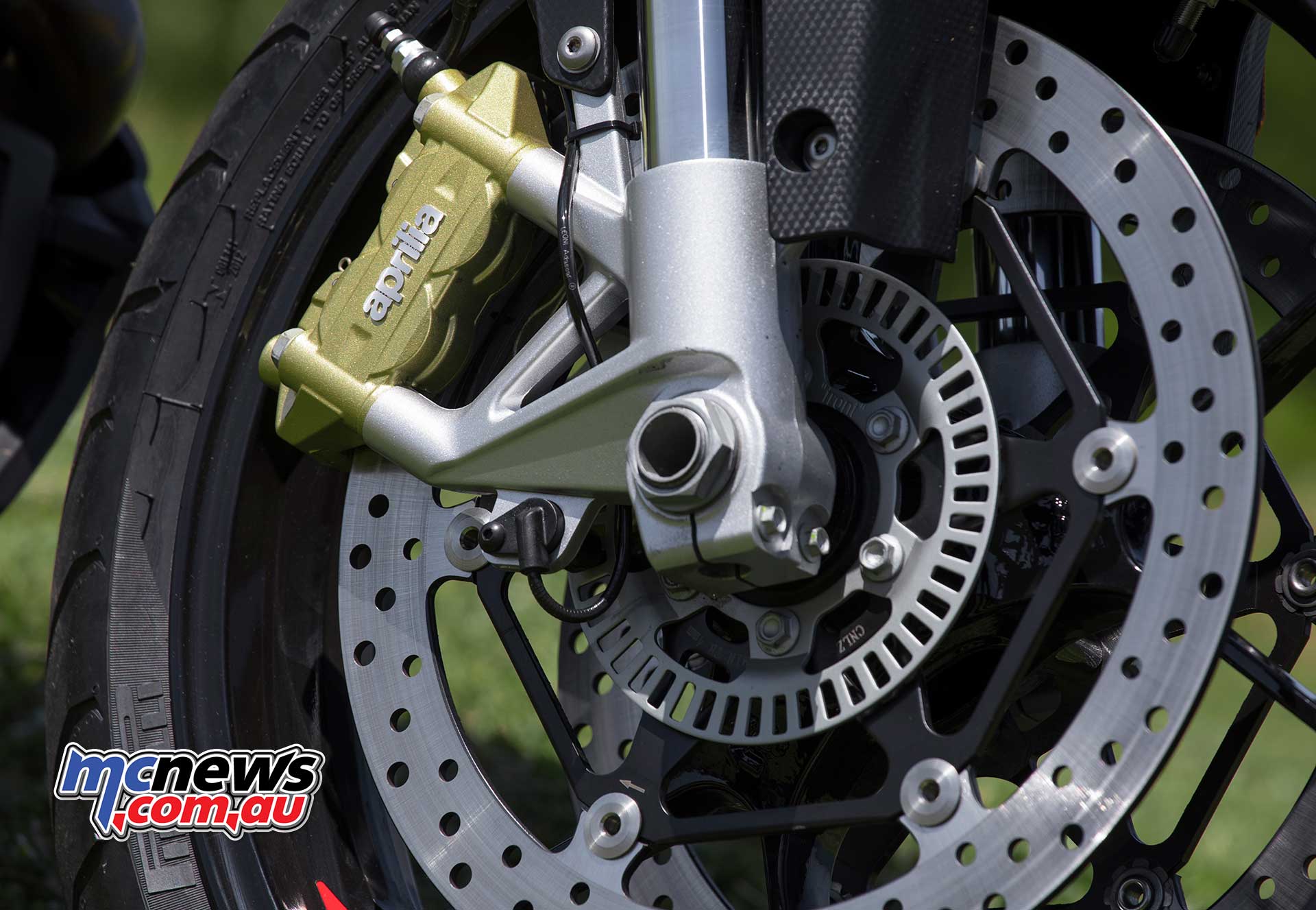
I am perhaps being fussy here. The brakes never faded, or complained, but did require more effort at the lever than I would have preferred when really up it for the rent.
The ABS system performed impeccably, was never intrusive, and like the traction control was also switchable. Nice.

An attractive new TFT dash, as seen on the latest of Aprilia’s V4 range, is very impressive. With the optional Aprilia Multi-Media Platform Connectivity installed it can also pair via Bluetooth to your phone, whereby the Aprilia software App can then log all aspects of your ride. It is an amazingly powerful suite of software that anoraks will love and is so detailed that it is worthy of an article of its own…
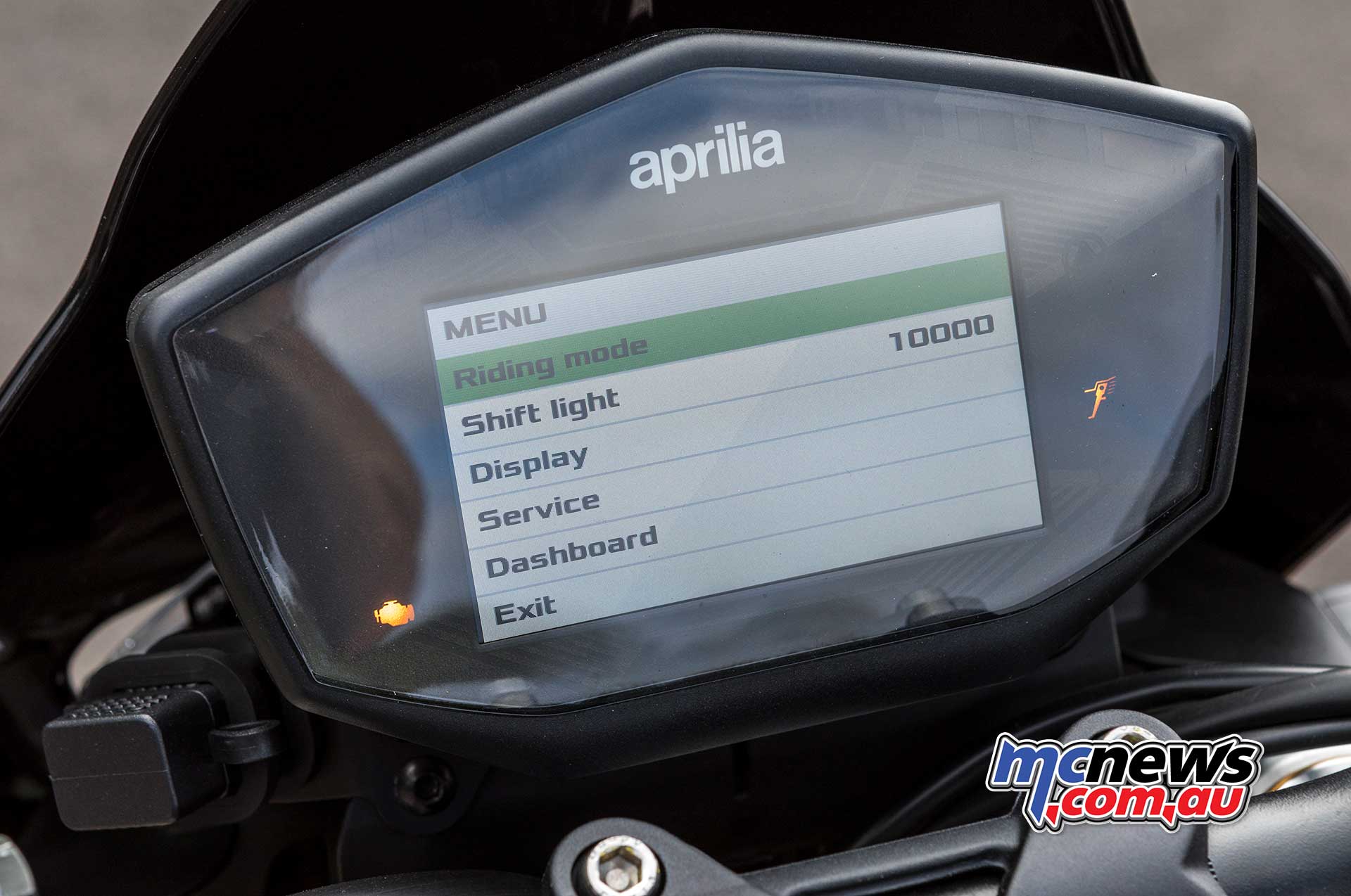
That said, I would trade the App functionality for a distance-to-empty function on the instrumentation. Immediate real-time fuel economy and average fuel consumption are featured in the detailed display, but a distance-to-empty is not available. With the Dorsoduo only carrying 11.5 litres of fuel, and the Shiver having a 14.5 litre fuel capacity, knowing how far you can get out of what’s left in the tank would be very welcome. A fuel light illuminates when three-litres are remaining. The only other thing missing, considering the top-end sophistication of the throttle-by-wire, traction control and ABS functions, is cruise control.
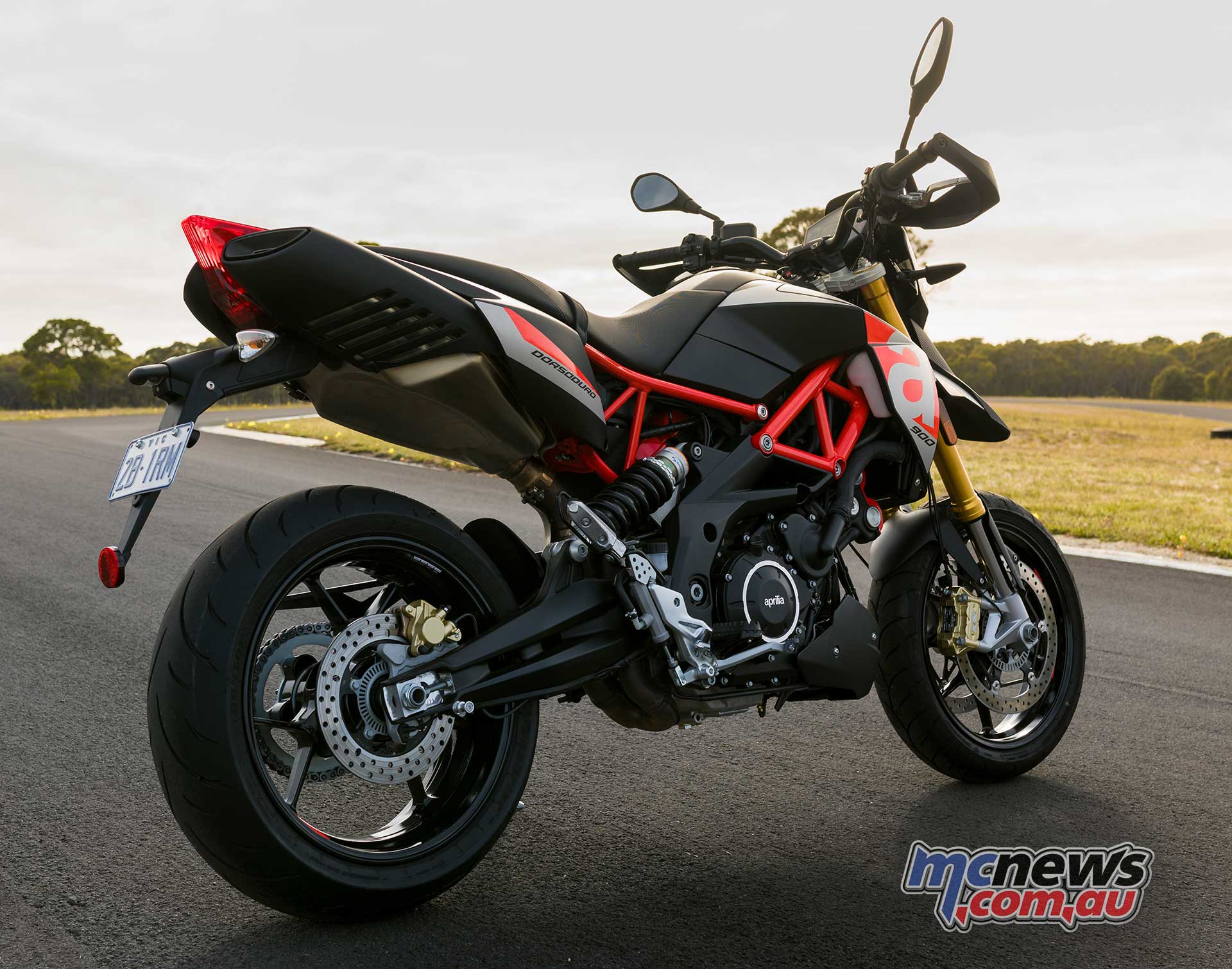
Chassis wise, both the Dorsoduro and Shiver are suspended by 41mm Kayaba inverted forks and a Sachs monoshock. Both ends are adjustable for preload and rebound damping. Triple clamps are tasty items forged from aluminium.
A steel trellis frame forms the backbone of the machines, however the Dorsoduro offers appreciably more travel. The Shiver has a fork-stroke of 127mm while the Supermoto-styled Dorsoduro has a more generous 168mm of travel.
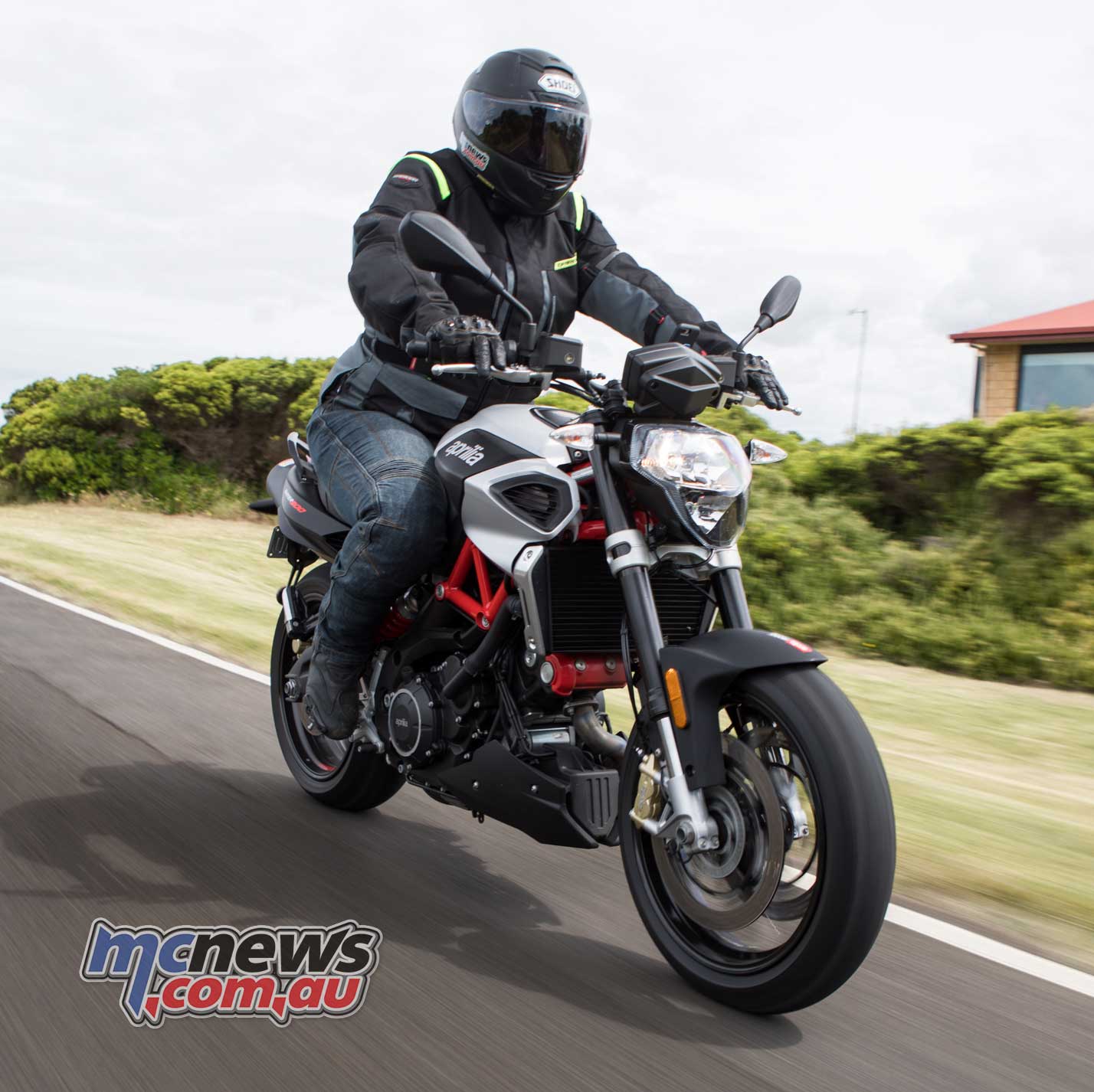
The Sachs monoshock is laterally mounted and gets by without a shock linkage. This is a compromised design common to many Vee configuration engines, largely made to provide room for the rear header, while still allowing for a relatively short 1465mm wheelbase in the Shiver, and 1515mm for the Dorsoduro.
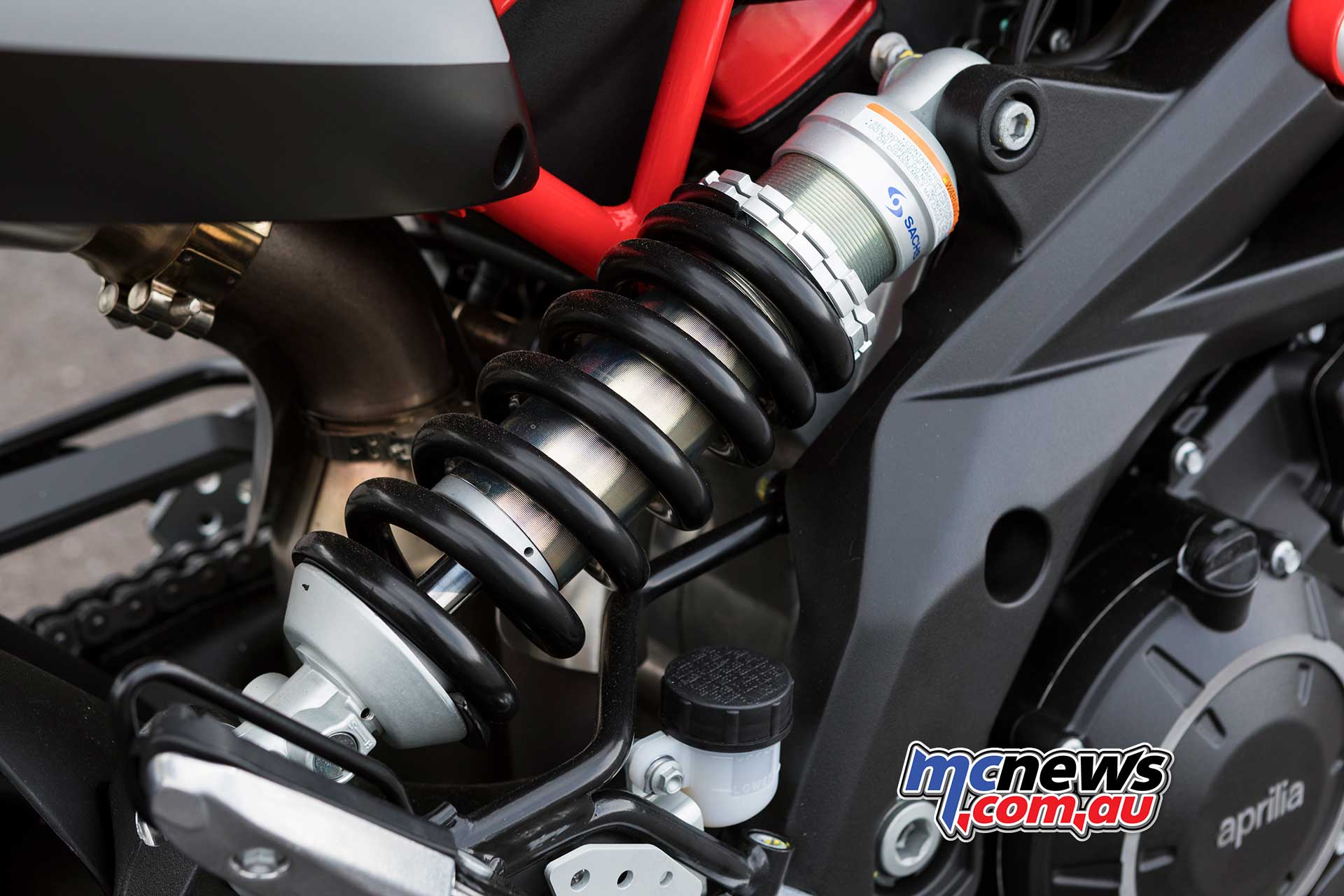
Overall the bikes are actually pretty comfortable. Mid-corner bumps at speed with lean can upset the machines a little, but if you are light on the pegs and ride with that in mind it poses no real hindrance. I would hazard a guess that we rode these bikes harder than most prospective owners ever will, and I never had any sort of ‘moment’, despite the heady pace amongst stellar quality riding companions.
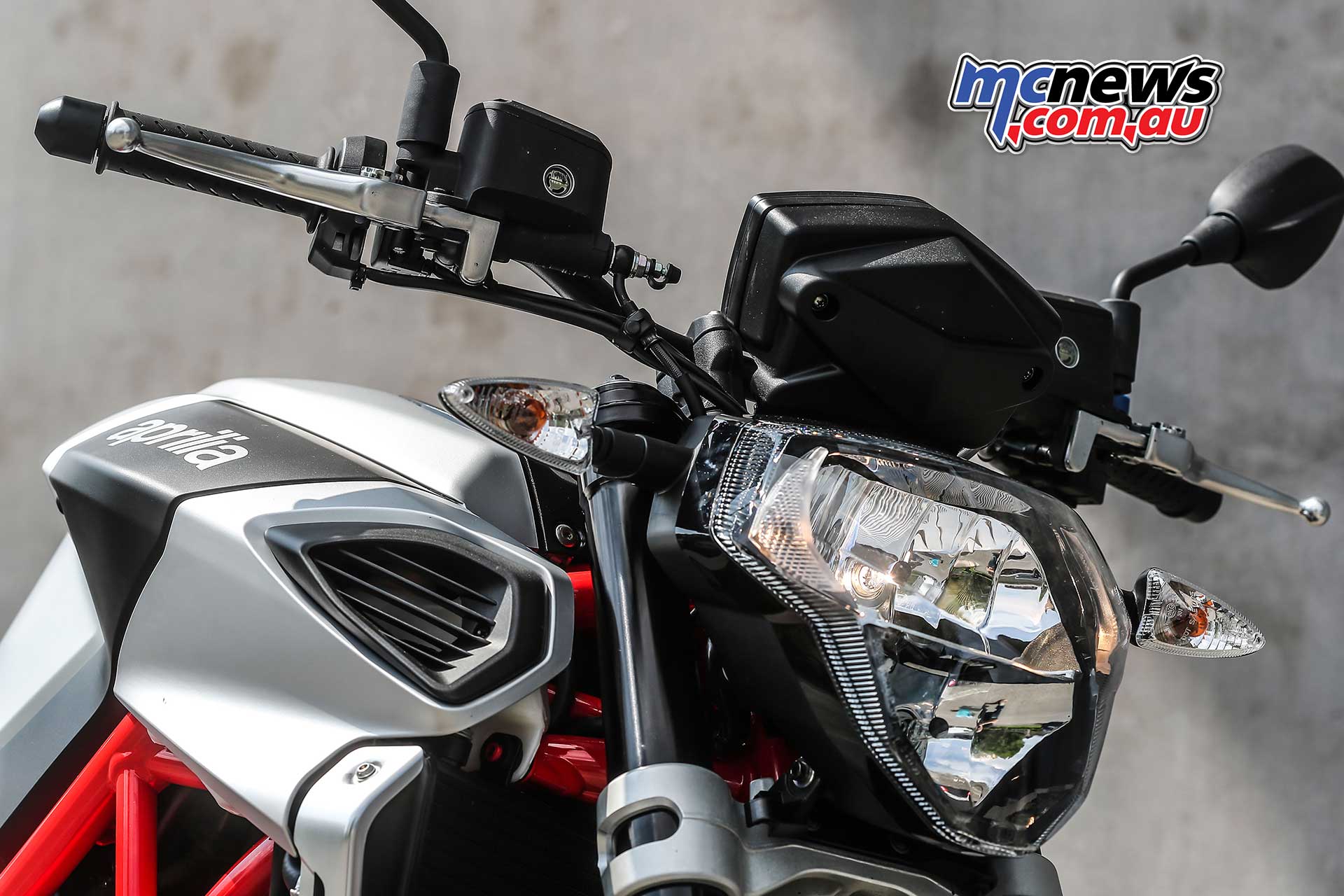
The Shiver does have less steering-lock angle than the Dorsoduro, which is certainly felt in parking situations. Gearing on the Dorsoduro is shorter than found on the Shiver, but still does not feel remotely busy at speed as the new engine just never feels hurried, stressed, or as though it is ever working hard.
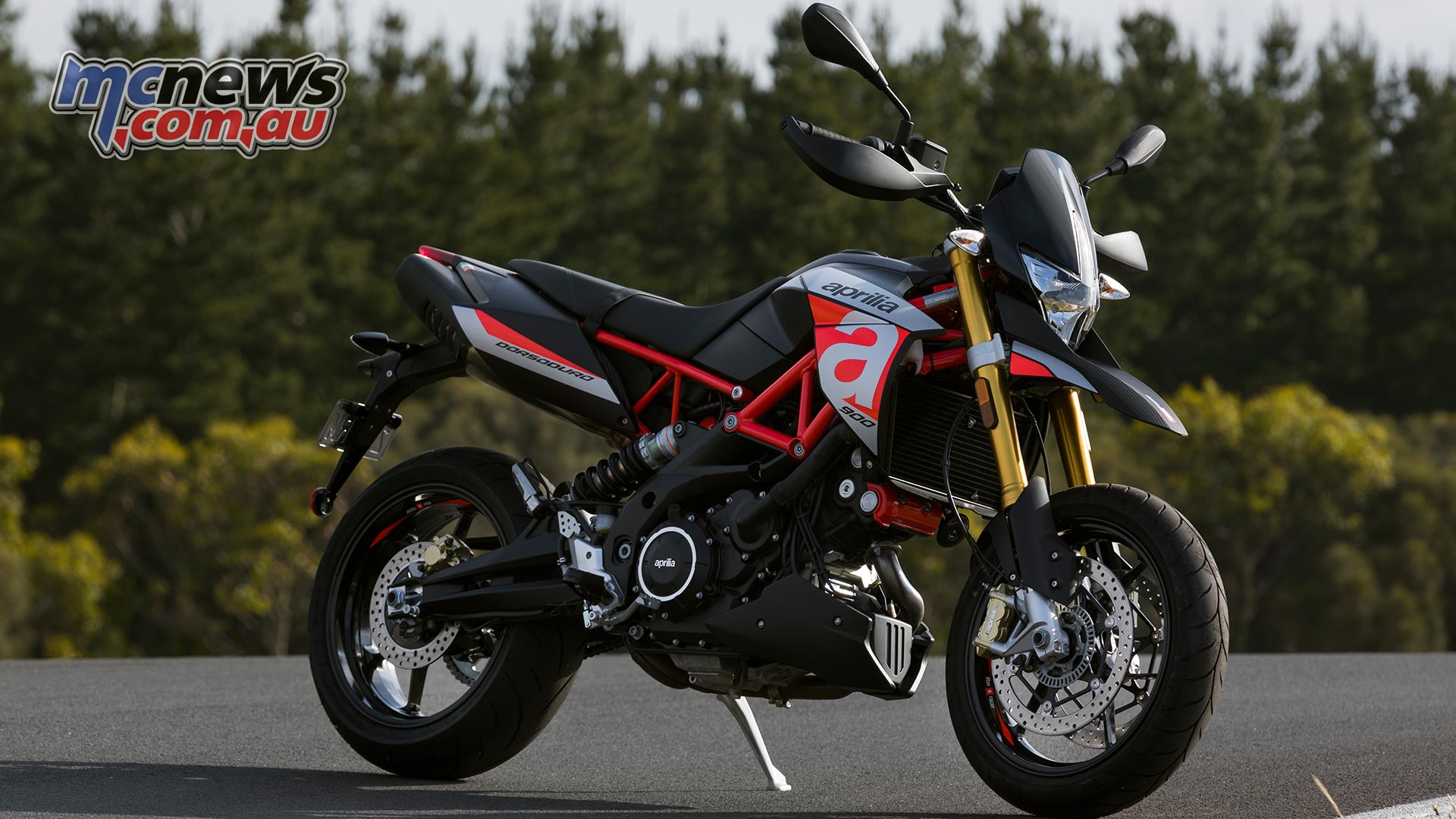
The swingarms are quite intricate and differ between the two machines, while the lightweight magnesium-alloy rims are pulled from the high-end RSV4 parts inventory.
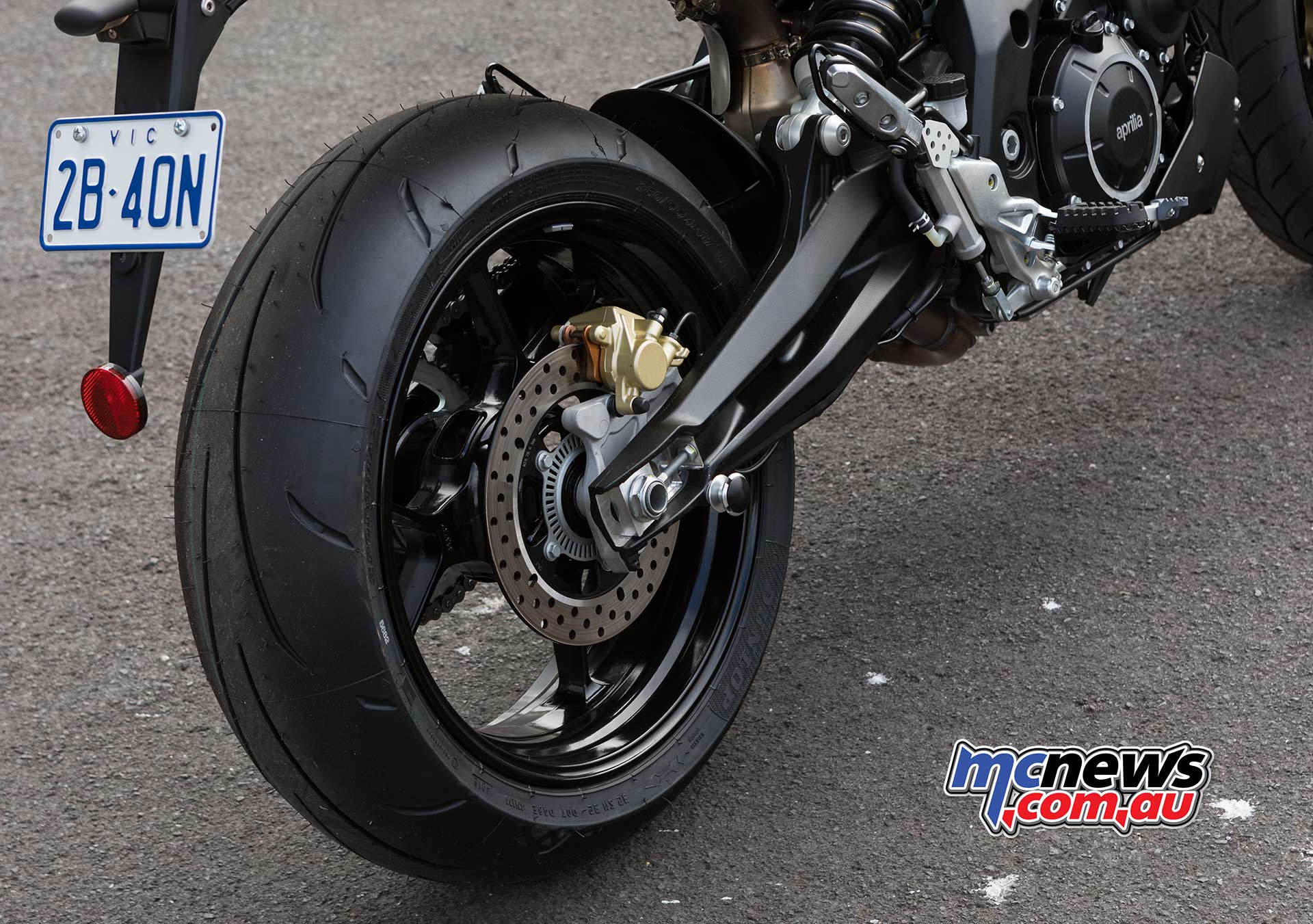
Neither machine is the least bit nervous in the handling department and that is largely thanks to a lengthy 114mm of trail for the Shiver, and a slightly more aggressive 108mm for the Dorsoduro. Rake is 26-degrees for both machines and I would say Aprilia has struck a good balance between agility and sure-footedness. They are however a little heavier than one would expect, 212kg for the Dorsoduro and 218kg for the Shiver. Half of that weight difference comes down to the extra three-litres of fuel carried by the Shiver.
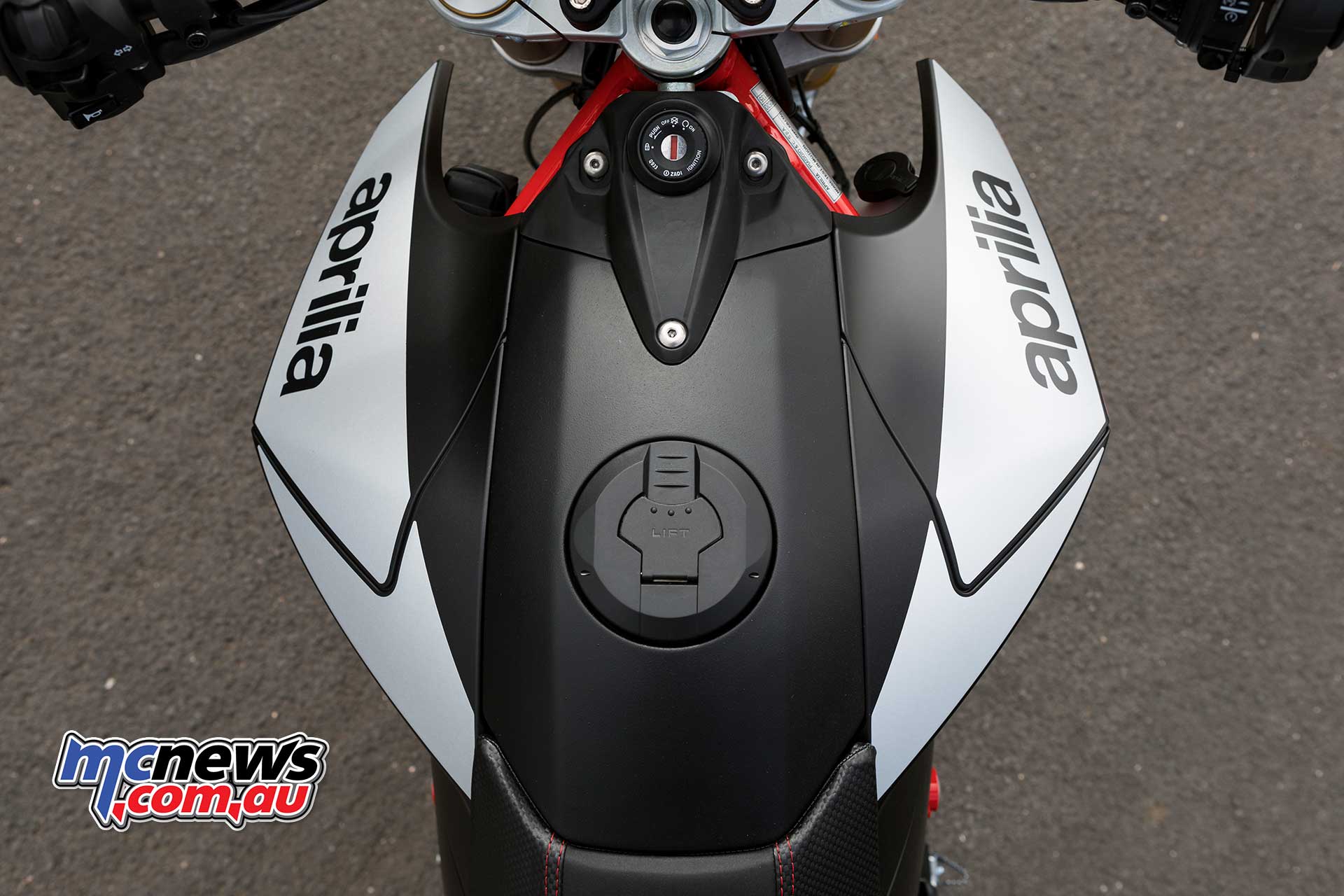
Ergonomics are fairly natural on both machines. Brake and clutch levers are adjustable for reach.
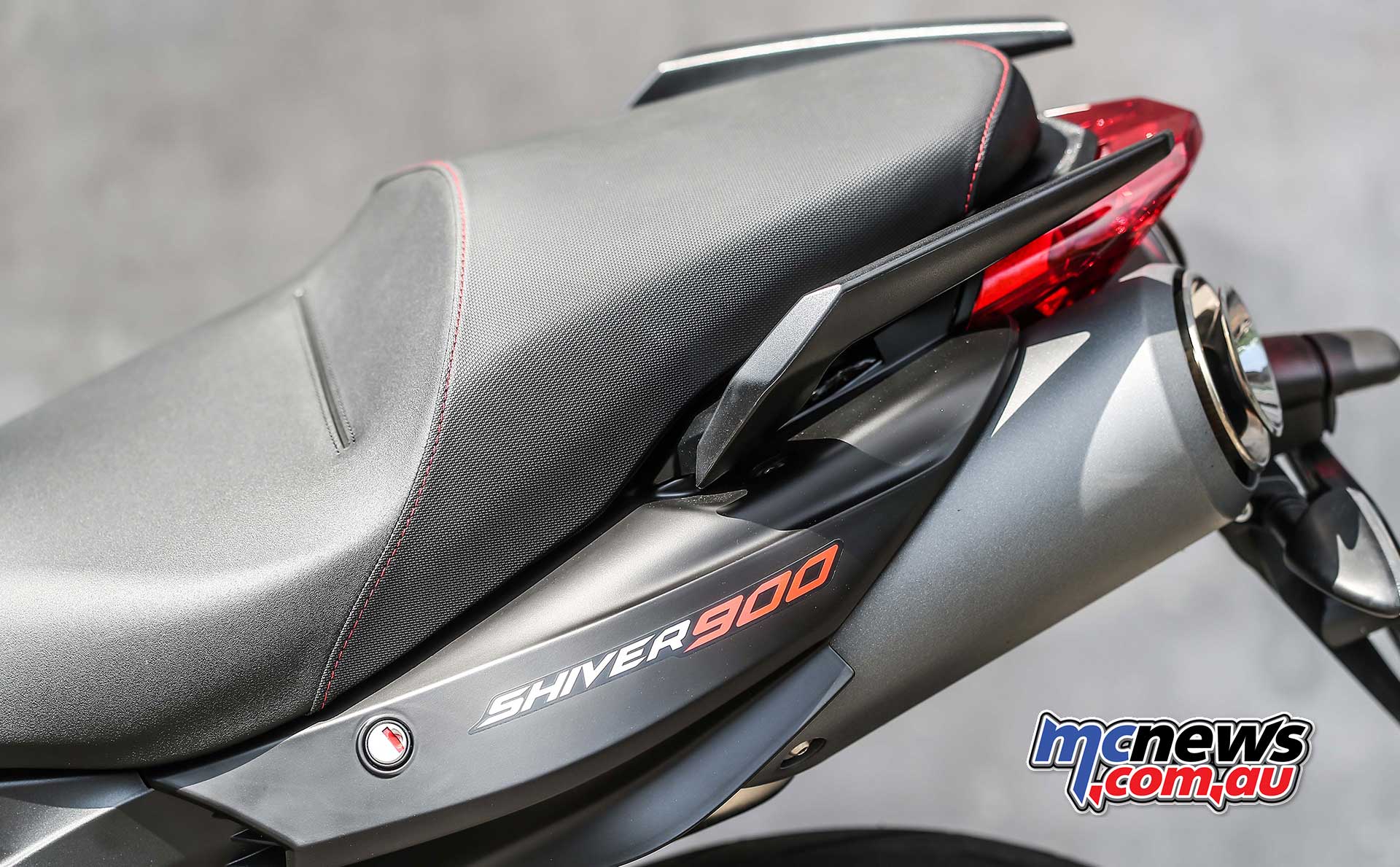
The seat on the Shiver was more agreeable than it looked and caused no complaint during a long day in the saddle. Seat time on the Dorsoduro was limited to the very busy 12-corners-in-2.4km McNamara Park circuit, thus I am not qualified to comment on its long-distance comfort. I suspect, however, that it’s actually not too bad.
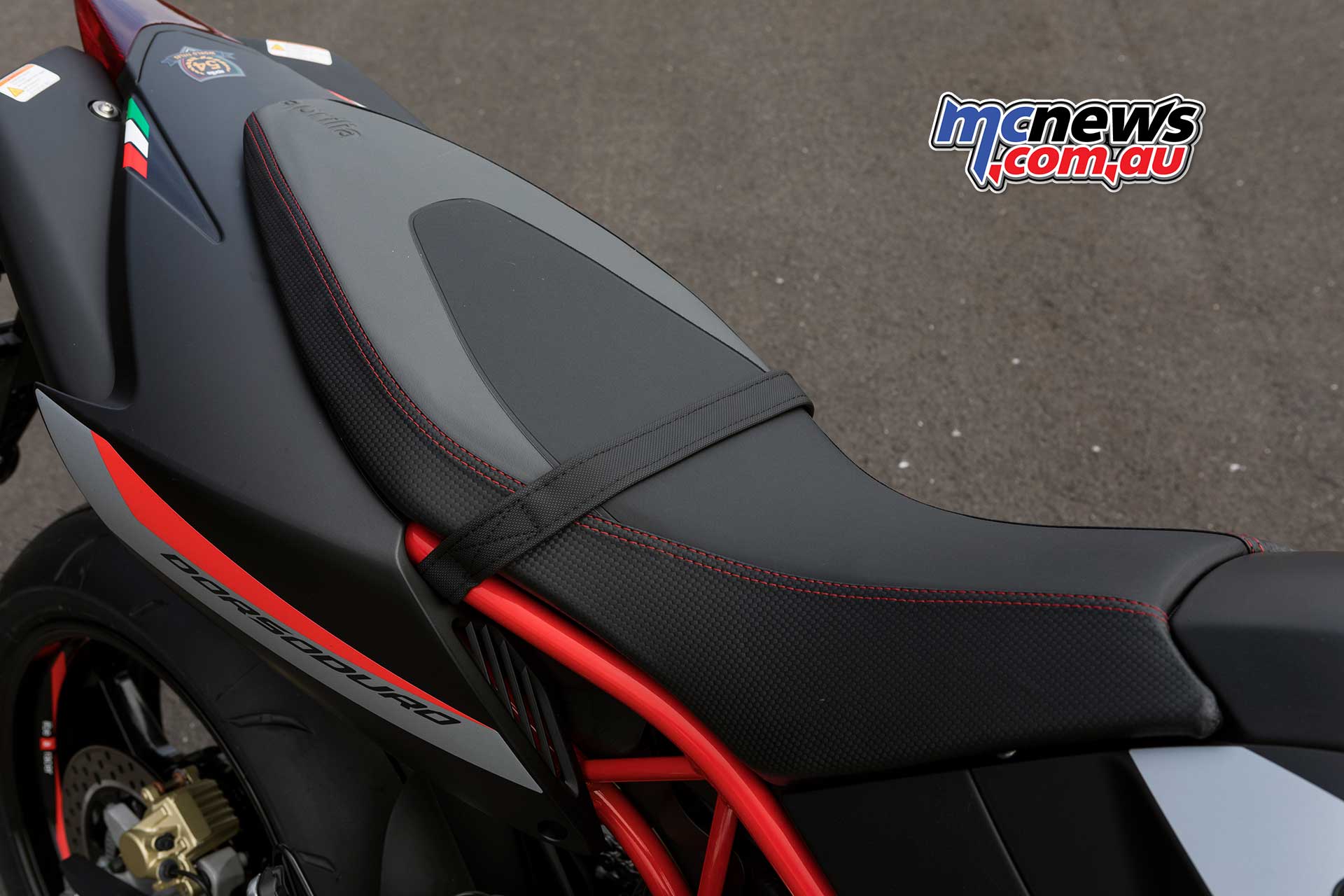
The Dorsoduro is a much more sit-on-top style of perch, befitting the Supermoto style with a seat height of 870mm, while the Shiver is more scalloped and a conventional sit-in style of pew, a much closer 810mm from the deck, and offers much better provisioning for a pillion.
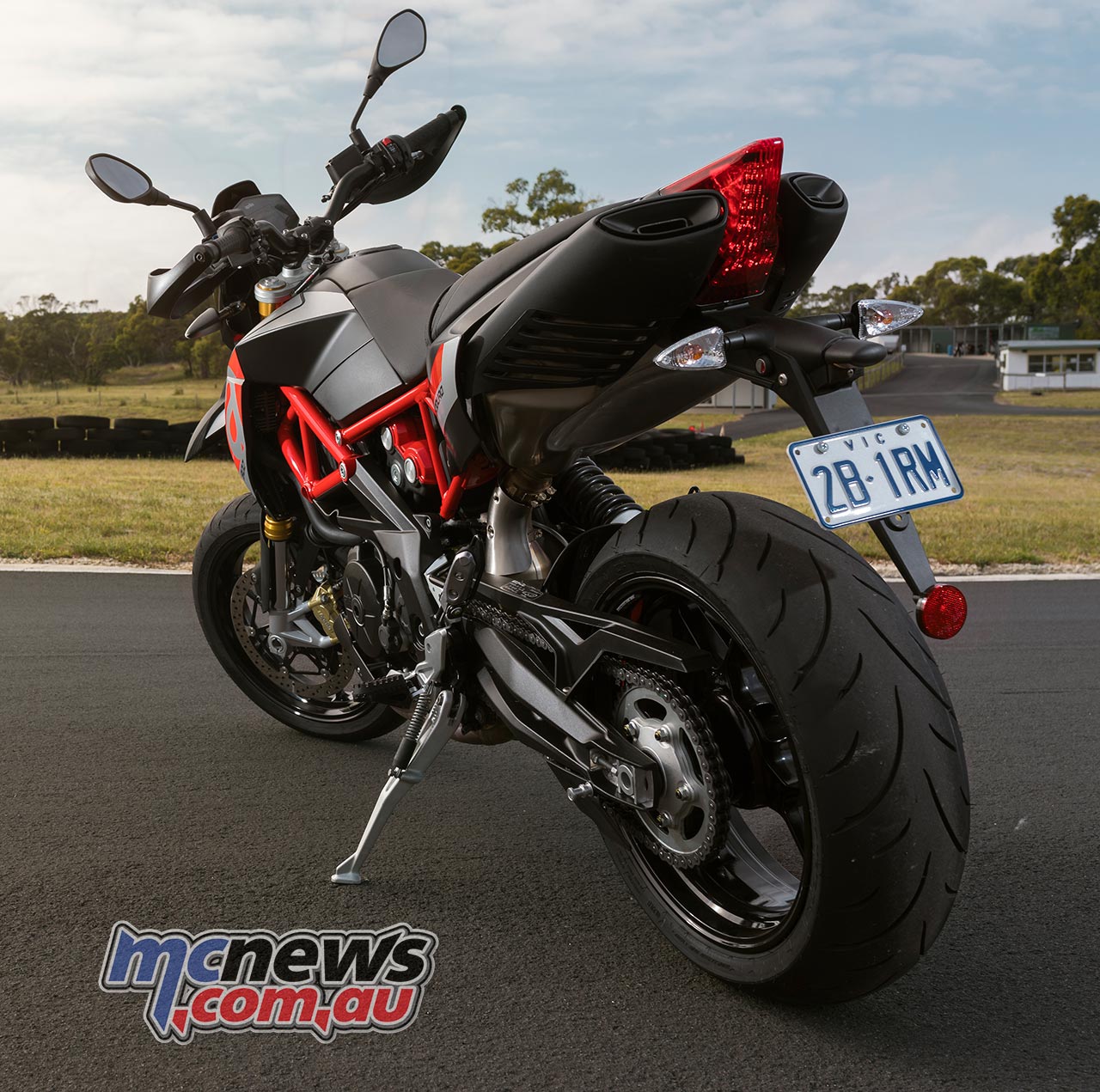
Are these two machines answers to questions that have never been asked?
Not really, I think they deserve their place in the market and come across as premium offerings. The Shiver, in particular, is a more than worthy competitor to BMW’s F 800 R and much of Ducati’s Monster range. And the latter of those two has certainly proved very popular indeed.

Perhaps it is a good strategy to lure more potential customers into the Aprilia tent. Most of Aprilia’s range is at the upper end of the performance sporting spectrum, and these machines are sharp new arrows in a quiver that might well attract new customers to the brand.
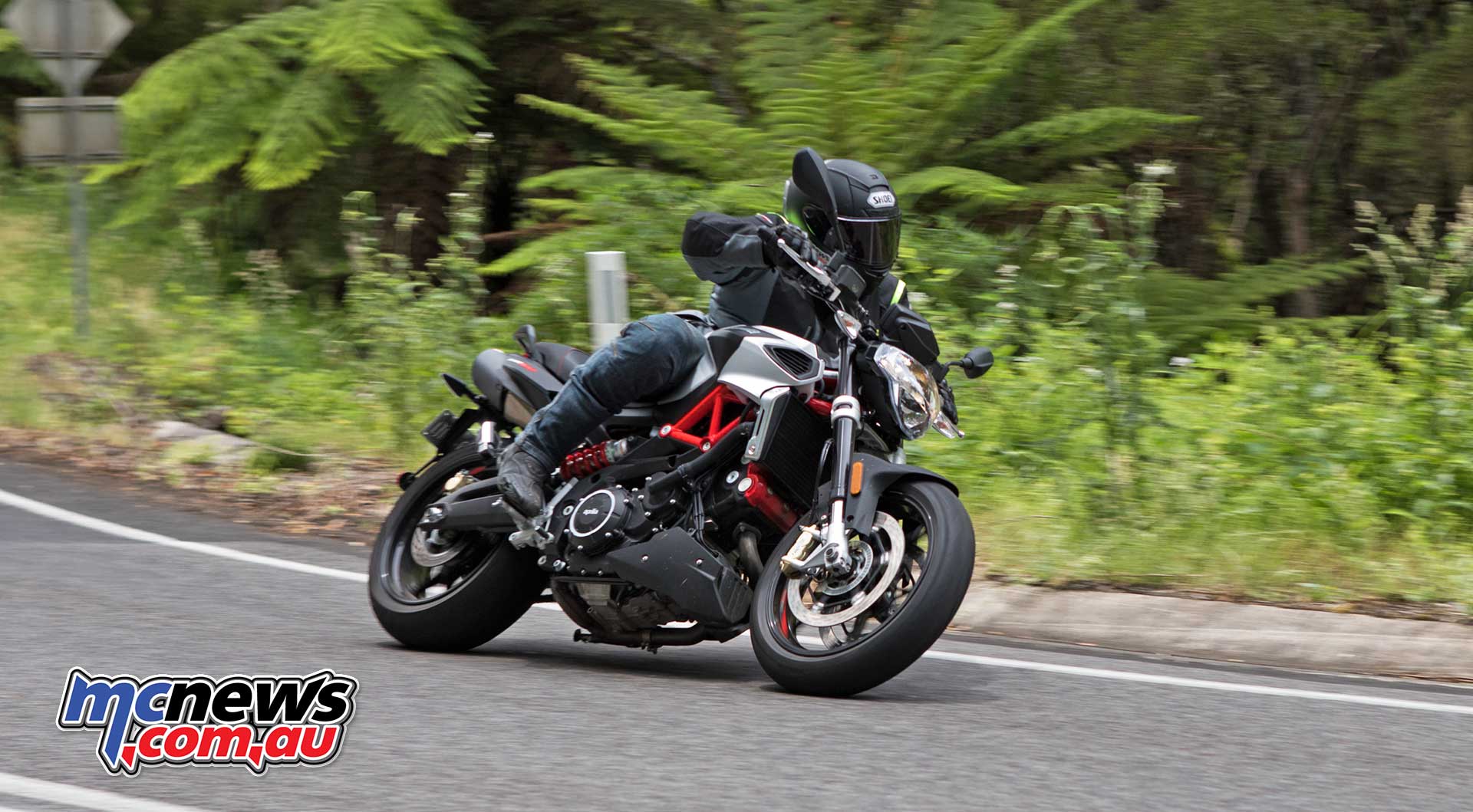
Both bikes sound great even on standard pipes, and the engine perhaps even feels a little bigger than its 896cc capacity. A pair of nice carbon cans, or even a shorty 2-1 system would likely play a thoroughly evocative tune, and provide an even more soulful soundtrack for carving the corners these two sharp new Italians were born to carve.
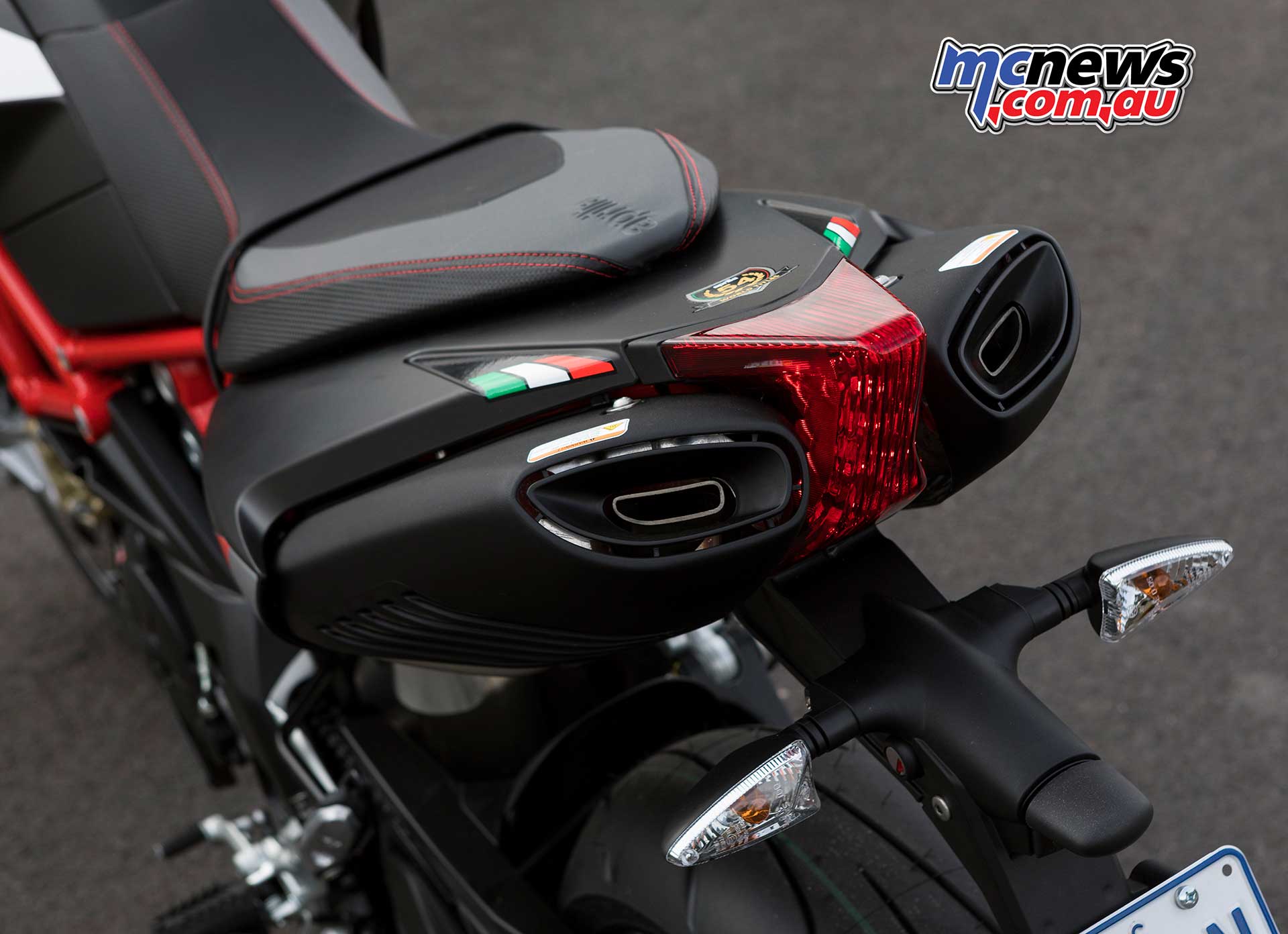
The Shiver retails from $15,190 + ORC while the Dorsoduro commands a $600 premium over its sibling.
While the Dorsoduro looks sexy and is great fun to ride, I feel the Shiver is the nicer all-round package and a machine any potential Ducati Monster buyer should try on for size.
If you are in the market for something different and with that charismatic V-Twin beat, it is certainly worth a visit to your local Aprilia dealer to try the machines out for yourself.
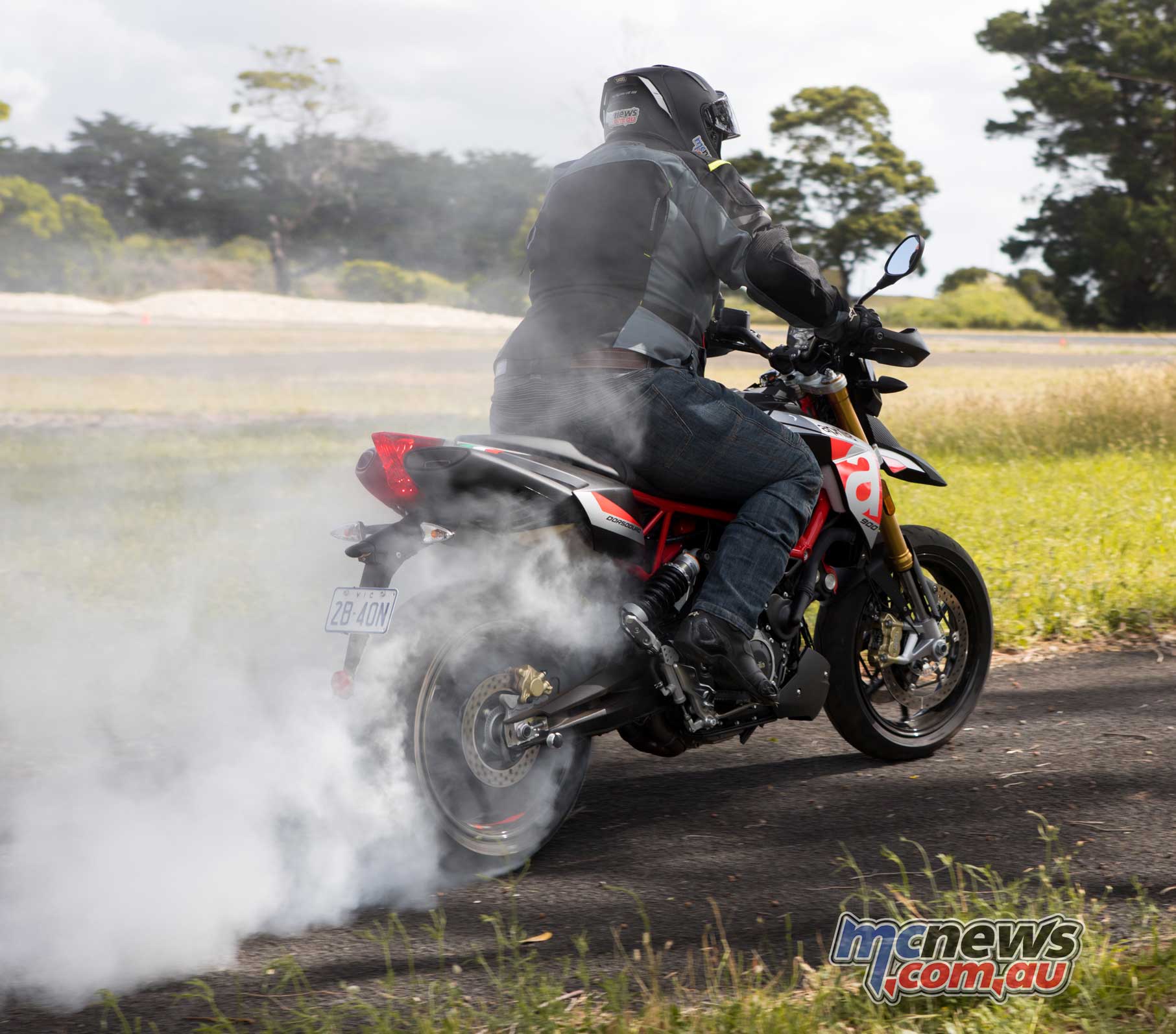
| SHIVER 900 SPECIFICATIONS | |
| DIMENSINS AND MASS | |
| Max. length | 2,130 mm |
| Max. width (at handlebar) | 810 mm |
| Max. height (at handlebars) | 1,110 mm |
| Wheelbase | 1,465 mm |
| Curb weight | 218 kg |
| Maximum carrying capacity | 215 kg (rider + passenger + luggage) |
| Seat Height | 810 mm |
| ENGINE & TRANSMISSION | |
| Type | 90° V-twin 4 stroke – 4 valves per cylinder – twin overhead cam |
| Overall capacity | 896.1 cc |
| Bore x Stroke | 92 x 67.4 mm |
| Compression ratio | 11.5 : 1 |
| Starter | Electric |
| Lubrication system | Semi-dry sump with oil scavenge valve & trochoidal pump |
| Air filter | Dry cartridge |
| Throttle control | 2 x 52 mm Marelli ride-by-wire |
| Engine management & control | Marelli 7SM electronic ECM |
| Ignition | Inductive (in-head) stick coil – Eldor |
| Standar spark plug – NGK CR8EKB – Gap 0.6 – 0.7 mm | |
| Fuel delivery | Multipoint digital electronic injection via pressure pump |
| Engine mapping | Sport / Touring / Rain – selectable via start button on the fly |
| Traction control | 3 levels – selectable via mode button on the fly |
| Cooling | Liquid |
| Clutch | Hydraulically actuated – wet multi-plate |
| Gearbox | 6 speed |
| Primary drive ratio | 40/69 |
| Drive ratio – 1st gear | 14/36 |
| Drive ratio – 2nd gear | 17/32 |
| Drive ratio – 3rd gear | 20/30 |
| Drive ratio – 4th gear | 22/28 |
| Drive ratio – 5th gear | 23/26 |
| Drive ratio – 6th gear | 24/25 |
| Final drive ratio | 16/44 |
| Drive chain | 525 endless o-ring 108 links |
| Final drive ratio | 16/44 |
| FRAME AND SUSPENSION | |
| Frame | High tensile steel trellis & cast alloy spars. |
| Steering rake angle | 26° (with suspension extended) |
| Trail | 114 mm |
| Front suspension | Kyaba hydraulic upside-down telescopic forks. |
| Stanchion diameter 41 mm | |
| Travel 127 mm | |
| Rear suspension | Sachs monoshock & specific cast alloy swingarm (Shiver) |
| Travel 43 +/- 1 mm | |
| BRAKES AND WHEELS | |
| Front Brake | Dual 320 mm floating discs & 4 piston radial callipers |
| Rear Brake | 240 mm disc & single piston calliper |
| ABS System | Continental dual channel |
| Wheels | Light-weight three spoke cast alloy |
| Front wheel | 3.50 x 17″ |
| Rear wheel | 6.00 x 17″ |
| TYRES | |
| Front | 120/70 ZR17″ (58W) |
| Rear | 180/55 ZR17″ (73W) or 190/55 ZR17 |
| Front tyre pressure | Rider only: 2.3 bar |
| Rider + passenger: 2.5 bar | |
| Rear tyre pressure | Rider only: 2.5 bar |
| Rider + passenger: 2.8 bar | |
| CAPACITIES | |
| Fuel | 14.5 Litres Min 95 RON |
| Fuel reserve | 3 Litres |
| Engine oil | 15W-50 Full Synthetic 3.0 Litres without filter change |
| 15W-50 Full Synthetic 3.2 Litres with filter change | |
| Coolant | Ethylene Glycol OAT 1.8 Litres |
| ELECTRICAL SYSTEM | |
| Battery | 12 V – 10 Ah YTX 12 – BS or 12 V – 12 Ah YTX 14 – BS |
| Alternator | Permanent magnet 450 W |
| LIGHTING | |
| High beam/low beam light | 12V – 55W/55W H4 |
| Front DRL | 12V – 5W x 2 |
| Turn indicators | 12 V – 10 W |
| Taillight/brake light | 12V- 5/21W x 2 |
| License plate light | 12 V – 5 W |
| SUSPENSION SETTINGS | FRONT |
| Spring preload – Rider only | 2nd notch – (two of four) |
| Spring preload – Rider & Passenger | 2nd notch – (two of four) |
| Rebound – Rider only | 6/7 clicks anti-clockwise from fully closed |
| Rebound Rider & Passenger | 6/7 clicks anti-clockwise from fully closed |
| Fork extension (base of clamp to axle CL) | 480 mm |
| RECOMMENDED SETTINGS | REAR |
| Spring length – Rider only | 168 mm |
| Spring length – Rider & Passenger | 160 mm |
| Rebound – Rider only | 12 clicks anti-clockwise from fully closed |
| Rebound Rider & Passenger | 6/7 clicks anti-clockwise from fully closed |
| DORSODURO 900 SPECIFICATIONS | |
| DIMENSIONS AND MASS | |
| Max. length | 2,185 mm |
| Max. width (at handlebar) | 905 mm |
| Max. height (at handlebars) | 1,185 mm |
| Wheelbase | 1,515 mm |
| Curb weight | 212 kg |
| Maximum carrying capacity | 217 kg (rider + passenger + luggage) |
| Seat Height | 870 mm |
| ENGINE & TRANSMISSION | |
| Type | 90° V-twin 4 stroke – 4 valves per cylinder – twin overhead cam |
| Overall capacity | 896.1 cc |
| Bore x Stroke | 92 x 67.4 mm |
| Compression ratio | 11.5 : 1 |
| Starter | Electric |
| Lubrication system | Semi-dry sump with oil scavenge valve & trochoidal pump |
| Air filter | Dry cartridge |
| Throttle control | 2 x 52 mm Marelli ride-by-wire |
| Engine management & control | Marelli 7SM electronic ECM |
| Ignition | Inductive (in-head) stick coil – Eldor |
| Standar spark plug – NGK CR8EKB – Gap 0.6 – 0.7 mm | |
| Fuel delivery | Multipoint digital electronic injection via pressure pump |
| Engine mapping | Sport / Touring / Rain – selectable via start button on the fly |
| Traction control | 3 levels – selectable via mode button on the fly |
| Cooling | Liquid |
| Clutch | Hydraulically actuated – wet multi-plate |
| Gearbox | 6 speed |
| Primary drive ratio | 40/69 |
| Drive ratio – 1st gear | 14/36 |
| Drive ratio – 2nd gear | 17/32 |
| Drive ratio – 3rd gear | 20/30 |
| Drive ratio – 4th gear | 22/28 |
| Drive ratio – 5th gear | 23/26 |
| Drive ratio – 6th gear | 24/25 |
| Final drive ratio | 15/44 |
| Drive chain | 525 endless o-ring 112 links |
| Final drive ratio | 15/44 |
| FRAME AND SUSPENSION | |
| Frame | High tensile steel trellis & cast alloy spars. |
| Steering rake angle | 26° (with suspension extended) |
| Trail | 108 mm |
| Front suspension | Kyaba hydraulic upside-down telescopic forks. |
| Stanchion diameter 41 mm | |
| Travel 168 mm | |
| Rear suspension | Sachs monoshock & specific cast alloy swingarm (Dorsoduro) |
| Travel 52 +/- 1 mm | |
| BRAKES AND WHEELS | |
| Front Brake | Dual 320 mm floating discs & 4 piston radial callipers |
| Rear Brake | 240 mm disc & single piston calliper |
| ABS System | Continental dual channel |
| Wheels | Light-weight three spoke cast alloy |
| Front wheel | 3.50 x 17″ |
| Rear wheel | 6.00 x 17″ |
| TYRES | |
| Front | 120/70 ZR17″ (58W) |
| Rear | 180/55 ZR17″ (73W) or 190/55 ZR17″ |
| Front tyre pressure | Rider only: 2.3 bar |
| Rider + passenger: 2.4 bar | |
| Rear tyre pressure | Rider only: 2.5 bar |
| Rider + passenger: 2.7 bar | |
| CAPACITIES | |
| Fuel | 11.5 Litres Min 95 RON |
| Fuel reserve | 3 Litres |
| Engine oil | 15W-50 Full Synthetic 3.0 Litres without filter change |
| 15W-50 Full Synthetic 3.2 Litres with filter change | |
| Coolant | Ethylene Glycol OAT 1.8 Litres |
| ELECTRICAL SYSTEM | |
| Battery | 12 V – 10 Ah YTX 12 – BS or 12 V – 12 Ah YTX 14 – BS |
| Alternator | Permanent magnet 450 W |
| LIGHTING | |
| High beam/low beam light | 12V – 60W/55W H4 |
| Front DRL | 12V – 6W H6 |
| Turn indicators | 12 V – 10 W |
| Taillight/brake light | LED |
| License plate light | 12 V – 5 W |
| SUSPENSION SETTINGS FRONT | |
| Spring preload – Rider only | 2nd notch – (two of four) |
| Spring preload – Rider & Passenger | 2nd notch – (two of four) |
| Rebound – Rider only | 6/7 clicks anti-clockwise from fully closed |
| Rebound Rider & Passenger | 6/7 clicks anti-clockwise from fully closed |
| Fork extension (base of clamp to axle CL) | 552 mm |
| RECOMMENDED SETTINGS REAR | |
| Spring length – Rider only | 170 mm |
| Spring length – Rider & Passenger | 170 mm |
| Rebound – Rider only | 17 clicks anti-clockwise from fully closed |
| Rebound Rider & Passenger | 12/14 clicks anti-clockwise from fully closed |























